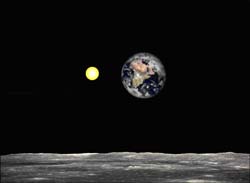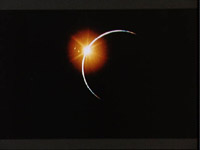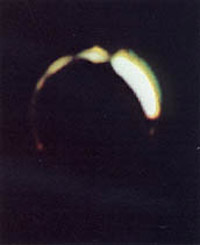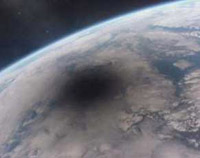Our planet Earth does sometimes eclipse the Sun in the lunar sky. This happens when the Moon passes through the Earth's shadow during a lunar eclipse. In this case we have a solar eclipse in the sky of the Moon, which is markedly different from the solar eclipses we observe from Earth.
The apparent size of the Sun in the lunar sky is nearly equal to that we see from the Earth, which is also almost equal to the apparent size of the Moon. As Earth's true diameter is approximately 4 times larger than that of the Moon, the apparent size of the Earth (in the lunar sky) is about four times larger than that of the Sun.
Fig (1) The apparent sizes of the Sun and the Earth in the sky of the Moon

Consequently, when the Sun is eclipsed by the Earth, the eclipse may last much longer than the terrestrial solar eclipses, in particular when the eclipse is central, i.e., when the Sun passes behind the center of the disk of the Earth. In general, a type of solar eclipses on the Moon is much longer than its terrestrial counterpart.
Also, during the eclipse, the Earth's atmosphere may glow as a reddish arc or ring due to scattering and refraction of sunlight in Earth's atmosphere.
A total eclipse of the Sun was imaged from the surface of the Moon on 24 April 1967 by NASA's spacecraft Surveyor III. Another eclipse of the Sun by the Earth was photographed by the Apollo 12 astronauts on their flight back from the Moon, but no astronaut viewed a solar eclipse in the sky of the Moon.
Fig (2) Eclipse of the Sun by Earth imaged by Apollo 12 astronauts

Fig (3) A total eclipse of the Sun seen from the Moon imaged by NASA's Surveyor III spacecraft

It is important to note that the Moon faces the Earth with one side (as the Moon rotates about its axis in the same period it makes one revolution around the Earth) and the solar eclipses will be observed only from the lunar hemisphere facing the Earth, the "Earthside ".
Partial solar eclipses occur on the Moon, but the total solar eclipses are more frequent. The annular type of solar eclipses can never be visible from the Moon, as the Earth is apparently much larger than the Sun.
Also, as the Moon lacks a substantial atmosphere, the daytime sky is always dark, and the stars are visible in the day, even when the Sun is not eclipsed! The difference between the day and night on the Moon is that at night the Sun is below the horizon and the ground is dark.
On watching a solar eclipse on Earth, an observer on the Moon would observe the lunar shadow as a dark patch sweeping across the Earth, i.e. the Earth is being eclipsed by the Moon. (This case is analogous to the lunar eclipses we observe from Earth.)
Fig (4) The lunar shadow sweeps across the surface of our planet

Further Reading
A Total Solar Eclipse on the Moon
http://science.nasa.gov/headlines/y2001/ast08jan_1.htm
Eclipses of the Sun Seen from the Moon
http://star-www.st-and.ac.uk/~awc/eclipse.html
Surveyor III
http://nssdc.gsfc.nasa.gov/database/MasterCatalog?sc=1967-035A |

